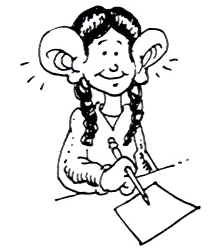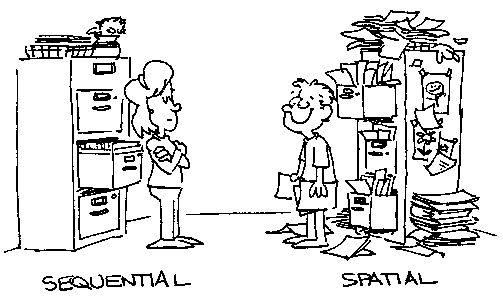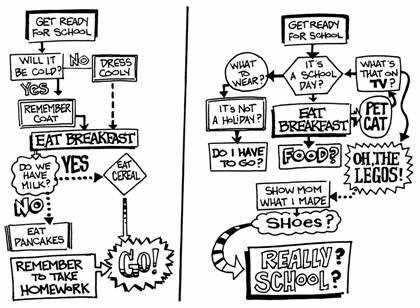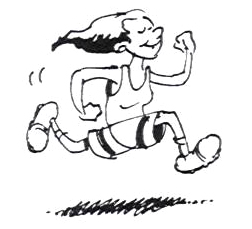Identifying your child’s specific learning style can be a tricky and often overwhelming task for parents especially when we learn differently from our own children. It is very important to identify how your child learns for their future success in school, and the earlier parents can pin point exactly how their child learns best, the better. It can sometimes be a long and frustrating process to determine which learning style your child tends to use. Start making observations about how they grasp information early on. Pay special attention to how they might try and understand something that is particularly difficult for them. When parents can recognize their child’s best way to learn, they can help their child learn more effectively. It is also important for the parents to identify their own ways of learning because we tend to teach in the way that we learn. Parents may need to change the ways in which they teach their child if the way they learn is different from the way their child learns. The more aware the parent is of their own learning style, the better it will be for teaching their child.
Although it is great to identify your child’s learning style, it is also worth mentioning that most people have a dominant learning style that they use. This may mean that while they have a heavy preference for one learning style, they may borrow ways of learning from other learning styles as well. If you are looking to determine what learning style your child favors, try giving them a project or learning activity and observe how they go about solving the problem or doing the activity. Asking them questions can be helpful too, especially for older children who are more aware of how they learn and are able to verbalize their thoughts better. Give them choices for how to complete an activity to help determine what learning style they may favor. For example, if your learning about sight words, ask them what their preference is: 1) listening to a song with sight words 2) writing down sight words in rainbow colors 3) coloring and cutting out pictures of sight words or 4) acting out the sight words. If they choose to listen to the sight words in a song, they may be an auditory learner or if they like acting out the sight words, they may favor the kinesthetic learning style.
There are three basic learning style groups that have been identified by experts. These basic styles include auditory,visual, and kinesthetic learning. Let’s explore each learning style:
Auditory or Language Learners
Auditory learners learn by hearing the information spoken. This is the style that is mostly taught in traditional school settings within The United States. These types of learners have more developed listening skills than their visual skills. Auditory learners are likely to:
- remember information by talking aloud
- need to have information explained to them orally
- have difficulty with written instructions
- talk to themselves while learning new information
- enjoy working in discussion groups versus working independently
So, does your child favor the auditory learning style? Here are some teaching strategies if you have a child that is an auditory learner:
- use music, songs, instruments, audiotapes whenever possible
- encourage reading out loud
- present information in a logical order, details are important to the auditory learner
- use classroom discussions
- encourage group work
Visual (spacial) Learners
Visual-spacial learners were once thought to be a small percentage of the population, but now it is thought that up to 20% of the population may favor this learning style. Visual-spacial learn through pictures. They like visual imagery and think in pictures that are often highly imaginative and detailed. Those pictures can often seem live movies in their heads. Visual-spacial learners can sometimes have difficulty in the later elementary school years because that is when the teaching content becomes less visual. For visual learners to make sense of information, they need to be able to visualize and/or illustrate the information that they are processing. This can sometimes cause a delay in processing because many times they need to change the auditory information into a visual picture. These learners can also struggle with auditory-sequential lists. They need to see something or have it demonstrated to make sense of the information. Visual-spacial learners often struggle with timed tests or memorization because they cannot get to an answer quickly. They need time to convert any written or oral information into picture form. They are often good at creative arts, building, technology, understanding maps and directions, puzzles, and understanding the mechanics of how things work. These children often end up with careers in engineering, computer programming, creative arts such as acting, and architecture just to name a few. Visual learners are highly imaginative and they are often very creative problem solvers. Visual-spacial learners can tend to have difficulty with details being taught to them. Often, they can arrive at an answer and don’t exactly know how they got there. They are global thinkers, meaning they focus on the overall big picture of a learning concept, not the details of that concept. Visual learners are likely to:
- remember visual details
- prefer to see or draw what they are learning
- need to doodle and have paper and pens handy
- understand instructions better through pictures of visual demonstrations
Do you think your child tends to favor the visual-spacial learning style? If so, here are some tips for teaching the visual-spacial learner:
- when teaching a new concept, give them the big picture up front. You will lose their attention if you start with the details.
- use visual aids in everything you teach. Maps, pictures and graphs will impact their learning more than written words or oral instruction
- provide models for the end product
- teach how to organize information pictorially
- teach how to take picture notes as well as word notes
- allow doodling or illustration while they are listening to information
- avoid timed tests. Teach time awareness and management
- increase the complexity of a concept if focus decreases. They need to be challenged, but tend to make careless mistakes on work as they are not focusing on details
- be fun! Being positive, funny and upbeat is extremely important to visual-spacial learners
A great resource to learn more about the visual-spacial learner is http://www.visualspatial.org/
This site really helps you to understand how the visual-spacial learner not only learns information, but often how they operate in the world around them. The sooner you can discover that as a parent, the better for you and your child. Below are a couple cartoons that showcase the difference between an auditory-sequential learner and a visual-spacial learner.
Kinesthetic Learners
Kinesthetic learners like to be active in a classroom or learning environment. They enjoy hands-on activities and learn through movement. These learners like to move, feel, touch, wiggle, dance, bounce, etc. They actively learn through their bodies and their sense of touch. These type of learners can be gifted in athletics, dance, or other physical activities. They have an excellent sense of their body in space as well as body timing. They usually have great hand-eye coordination and quick physical reactions. Kinesthetic learners want to:
- always “do” anything that is being learned
- move around while they are listening or talking
- talk with their hands
- look around and touch things as they are learning
- recall events and information by remembering who did what versus what someone said
How to help the kinethetic learner:
- encourage them to repeat movements. This helps them focus and remember what they have learned
- use skits and gestures for learning new concepts
- give them objects to manipulate instead of a pencil and paper. This allows them to focus easier
- teach them to visualize themselves doing something when learning new concepts
- let them illustrate learning concepts
- let them move and give them movement breaks throughout the day
It is important to note that visual-spacial learners and kinesthetic learners often get misdiagnosed with ADD/ADHD because traditional learning environments are challenging for them. Visual-spacial learners often have difficulty focusing on tasks or information that is presented with many sequential details and can have difficulty filtering out background noise around them. The lack of focus is sometimes mistaken for ADHD. Kinesthetic learners have great difficulty sitting still in a traditional school environment. Getting up, moving, and doing things opposed to listening and watching things is generally not accepted in the school environment.
If you are looking to identify your child’s preference for learning, take the online quiz at http://www.scholastic.com/parents/tools
I hope this helps you identify how your child learns best!





Recent Comments